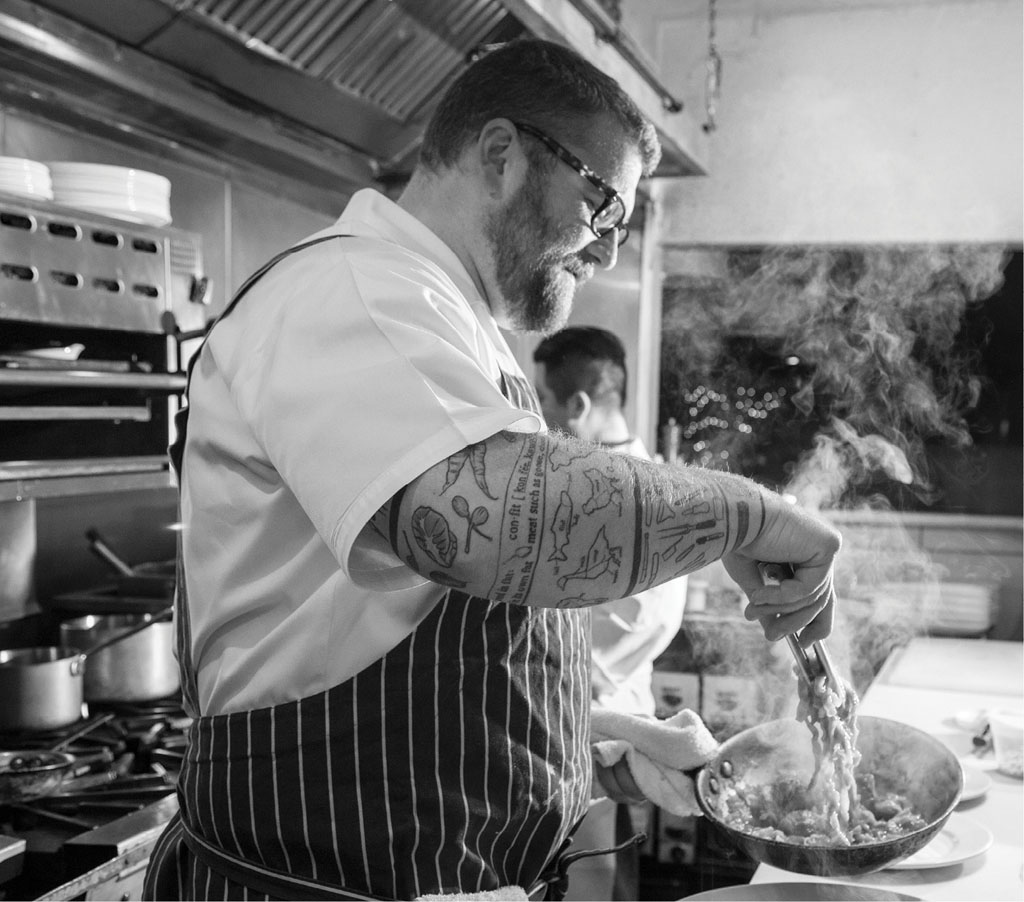

“It’s this trading of art; my food for his ink. I always think I get the better end of the deal.”
—Ben de Vries
Ben de Vries’s mother and grandmother raised him in Ann Arbor, Michigan, which is where he first fell in love with food. Helping his grandmother often in the kitchen, Ben was only six when he announced he would like to be a chef and own his own restaurant. Then, Ben spent his junior year of high school in Paris, where he was introduced to the culinary arts at a friend’s restaurant. After high school, Ben moved to Vermont to study at the New England Culinary Institute; he then went on to staging, similar to a culinary internship, at restaurants on Cape Cod and Nantucket and in New York City. He eventually moved to San Francisco to continue his culinary career in a city he wanted to live in, a decision that quickly paid off. He says, “I got off the plane New Year’s Day 1994, and within an hour I got a job offer, got an offer for a place to stay, and met my current wife.”
As Ben settled into San Francisco, he also took a position as a sous-chef at LuLu, a Provençal restaurant serving simple rustic foods family-style from a wood-fired oven. Ben also helped launch Scala’s Bistro and Vertigo before becoming opening sous-chef at the French-Japanese restaurant mc2. In 2004, Ben worked as an executive chef at Andalu, a restaurant focused on an eclectic mix of small plates to share with the goal of having interaction among the guests be as important as the food. Andalu caught the attention of The New York Times, Bon Appétit, Food & Wine, and Gourmet, among other national media outlets. That same year, Ben went on to open his own restaurant, Luella.
With Luella, Ben was finally free to explore his style of cooking. He says, “I appreciate food that doesn’t try to be something it’s not.” Luella’s menu can best be described as contemporary American, with roots in Italy, Spain, and France. Dishes are robust and straightforward and not complicated by heavy sauces. Luella’s modern California cuisine acquired a Bauer two-and-a-half-star review from the San Francisco Chronicle in 2009 and has also received many accolades from Northside San Francisco, Gayot, 7x7, and San Francisco magazine.
Ben started to get his very organized culinary tattoos almost nine years ago. His right arm starting at his wrist showcases the ingredients for bouquet garni, the bundle of herbs usually tied together with string and used to prepare soup, stock, and various stews. Moving up his arm is a picture of the knife kit that Ben uses in the kitchen, followed by the butcher charts for pig, chicken, cow, and sheep. The last tattoo on this arm is the definition for confit—“con•fit [con fée, kawN fee] (plural con•fits) meat cooked and preserved in fat: such as goose, duck, or pork that has been cooked and preserved in its own fat”—followed by vegetables. Ben’s largest tattoo showcases a leg of jamón ibérico, Spain’s famous cured ham made from pigs raised on acorns, that runs down his right thigh. Next to it sits his pinup girl chef with her own “I heart pork” tattoo. Ben also has several religious symbols from various religions wrapping his ankle, as well as many classic herbs around his calf like parsley and rosemary.
Ben attributes his ink to two people: Renee Silvestri, a good friend and a hostess at Luella who drew most of the art, and Greg Rojas, a tattoo artist from Seventh Son Tattoo in San Francisco. Ben says, “[Rojas] and I have sat for a total of over one hundred hours. It’s a good thing that he likes food because otherwise I could never afford it.” Over all that time, Greg and Ben have become good friends. “It’s new age-y to a certain degree, but if someone is putting something permanent like that on your body, there is a certain energy that comes with it, and to have somebody you like and feel good with makes a whole world of difference.”
This dish has been a signature dish for Luella since it opened. Ben has tried to pull it from the menu a few times, but each time enough customers have asked that he has had to put it back on. Like a band that has a song fly to the top of the charts but has long since written new material, sometimes chefs can’t escape certain dishes.

NOTES FROM THE CHEF
Sometimes what seems like an incongruous ingredient can make the most spectacular dish. The secret: Coca-Cola. People may not be able to pick out its distinctive flavor, but it brings out the best in this cut of pork. Cooling the meat overnight: After cooking, the meat is left in the braising liquid, which intensifies the flavor and tenderness.